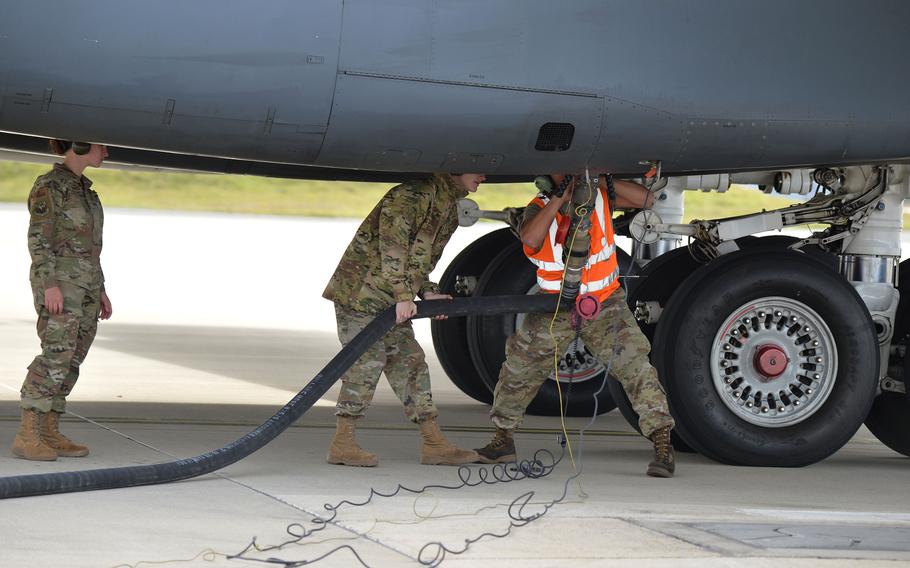
Airmen refuel a B-1B Lancer at Spangdahlem Air Base, Germany, Oct. 11, 2021. A pair, from the 9th Expeditionary Bomb Squadron, Dyess Air Force Base, Texas, refueled at Spangdahlem, using the Versatile Integrating Partner Equipment Refueling kit to take on fuel. (Michael Abrams/Stars and Stripes)
SPANGDAHLEM AIR BASE, Germany — The pilots of two B1-B Lancer bombers rumbled off the runway a little faster this week, thanks to the invention of a couple of enterprising airmen.
Monday marked the first time the Texas-based Lancers had ever visited this rural U.S. base in western Germany, and the first time they used the Versatile Integrating Partner Equipment Refueling kit, or VIPER.
The bombers parked on the flight line, which was nearly empty for the Columbus Day holiday, and kept their engines running for hot pit refueling.
Airmen with the 52nd Logistics Readiness Squadron pumped each plane with about 4,500 gallons of fuel for 40 minutes.
Hot pit refueling isn’t new, but being able to do it with a 375-pound kit, adaptable to any U.S. Air Force aircraft and the infrastructure of foreign allies, is the stuff of dreams for logistics planners.
The VIPER system should eliminate the need to send U.S. refueling trucks to other bases and countries for the same purpose.
The kit was named a “fan favorite” and a top-five finalist this year at the Air Force’s Spark Tank, a competition that encourages airmen to pitch innovative ideas to solve operational problems.
It ensures that “we don’t overpressurize our aircraft,” said Master Sgt. Jason Yunker, the 52nd Logistics Readiness Squadron section chief of fuels operations, who created the system with Master Sgt. Timothy Peters.
The kit uses parts already in the service’s inventory, Yunker said.
“I just took them off other pieces of equipment and built them into the VIPER kit to make something that’s really light and lean so we can move faster,” he said.
Up until Monday, the kit had been used only on F-16 Fighting Falcons in Europe, U.S. Air Forces Europe-Air Forces Africa officials said.
A California company is building more VIPER kits, which will be distributed to various locations in Europe and the Pacific by the end of this year, Air Force officials said.
Yunker said he was amazed to see the VIPER kit used on the B1-Bs, which are normally based at Dyess Air Force Base. Four Lancers and 200 airmen deployed to RAF Fairford in England last week with the 9th Expeditionary Bomb Squadron for a long-planned European mission.
The Lancers landed at Spangdahlem on Monday following a flight to the Baltics, where they trained with allied joint terminal attack controllers over Lithuania.